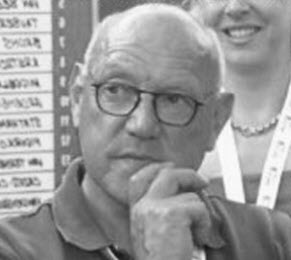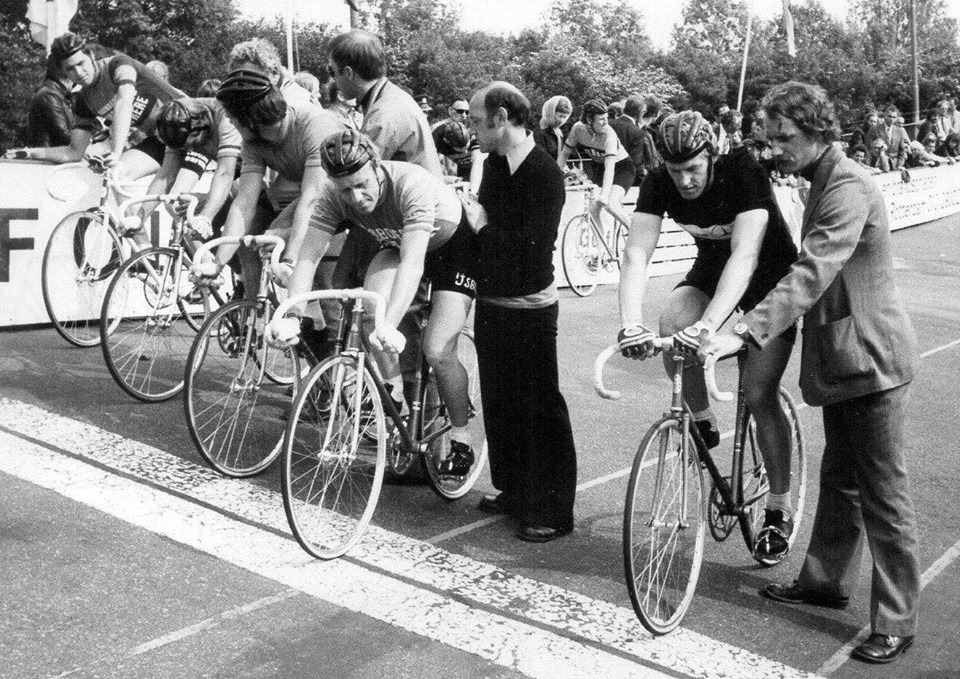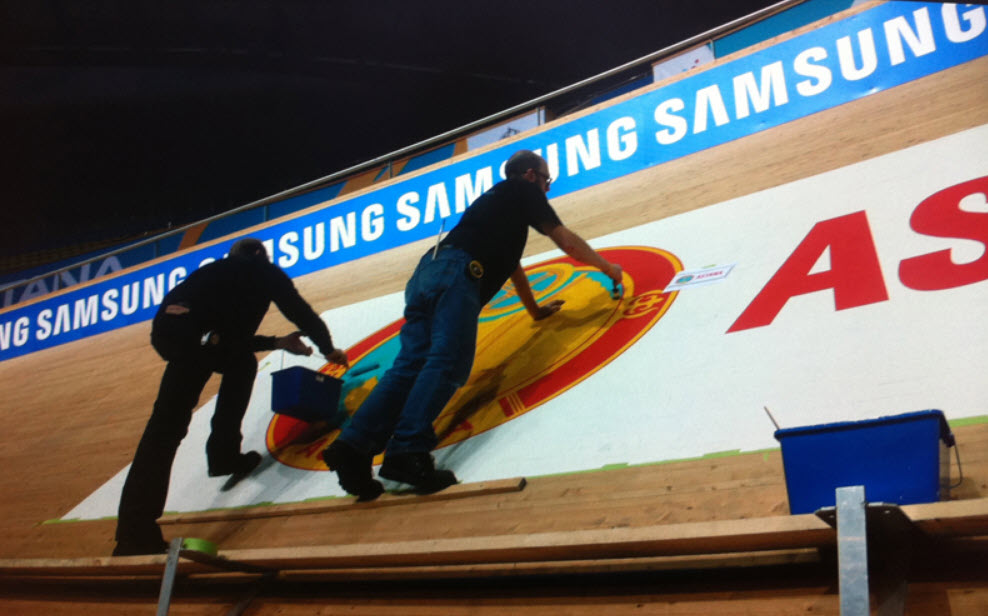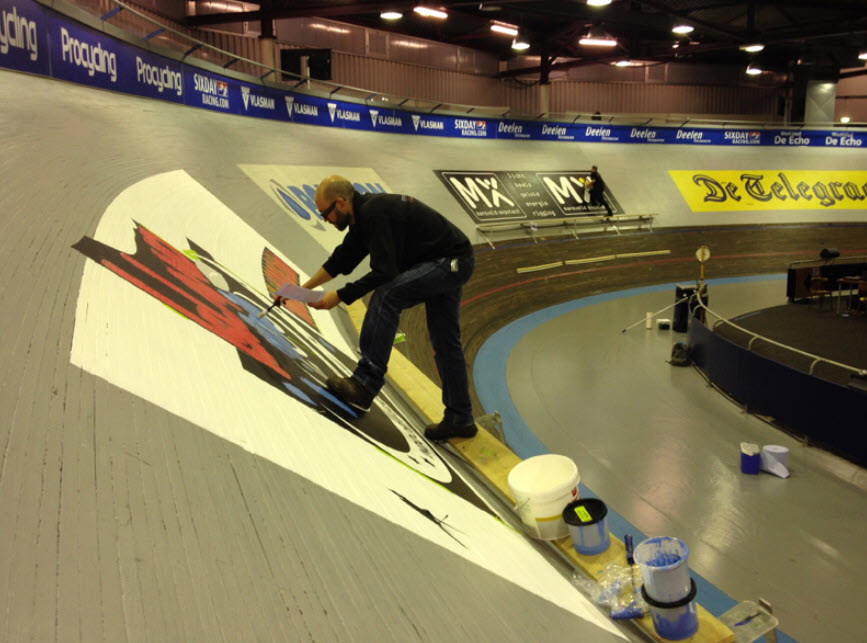
Our old friend and former Six Day man, ‘Brit,’ Norman Hill suggested to us that we should ‘have a word’ with the man who was his Six Day ‘runner’ on the winter boards circuit back when there were up to 17 Six Day races every winter, Marvin Smart.
Not only did Marvin ‘run’ for some of the biggest names in the sport, he was an innovator in the field of advertising on the actual track surface – such an important factor in a Six Day organiser’s budget plans.
Here’s what Marvin had to say to us recently.
Did you race, Marvin?
“During my study at Shrewsbury School of Art, I raced mainly on the track, I had to divide my time between studying and training. I needed less training time for the track, mainly sprinting as a junior, protégé of the late Benny Foster who was then National Coach.
“On the road, as a junior I won a couple of races that ended in sprints but I liked track racing more and concentrated on that.
“I rode open meetings and track leagues – until I got suspended for swearing at a rider who pushed me into the balustrade ‘til my knuckles bled.
“Someone in the stands heard my ‘effing and blinding’ and put in a complaint as there were ‘women around.’
“I stopped racing altogether after that and concentrated on my ‘student life’.
“After my study in Shrewsbury ended, I went to work for an advertising bureau as designer for commercial adverts. I knew this wouldn’t last long as I had a strong feeling of wanting to get out of England to do something different and see other things.
“One day, there was a knock at the door of my parent’s house from a Dutchman named Charles Ruys, who was a promoter and impresario in the cycling world. He came over to England as he was promised the job of Federation National Coach, which went in the end to British, ex-double world amateur pursuit champion, Norman Sheil.
“Ruys had an opportunity to start a sponsored local team by the Shropshire Star newspaper. There was one condition and that was they needed to see that their team was capable of winning races.
“Ruys talked to the local cycling club to ask if there was any club member capable of pulling off a win. Someone mentioned my name but told him that I didn’t race any more.
“This didn’t deter Ruys and before we had finished our conversation, I was enthusiastic enough to promise to be part of the team once I had done a few weeks training.
“Within a couple of weeks I had my first win at a track meeting in Wolverhampton. This got Ruys the sponsorship he needed to fit out the team in jerseys, shorts and tracksuits, and this drew cyclists with international reputation to the club.”
I believe you had your share of crashes?
“At a track meeting, by chance at Wolverhampton again, there was a Commonwealth Games selection team against ‘the Rest’.
“There was an athletics meeting going on concurrently.
“I was in the final against a guy called Ian Alsop [multiple British champion and 1966 Commonwealth Games 10 mile Champion, ed.] from the selection and in a neck and neck finish we crossed the line.
“Even today I don’t know who won as I ran into an athletics official who crossed the track at that exact moment.
“I ended up unconscious in hospital with five cracked and dislocated vertebrae. That kept me quiet for a few months.
“During my stay in hospital, I decided that I would definitely leave Britain. My first choice was America, as I had family living there. I was made aware that to get work one needed a Green Card and that meant doing National Service and being used as shell-fodder in Vietnam.”
How did you arrive in The Netherlands?
“I told Ruys what I was thinking and he said; ‘why not go to Holland?’ He had an address for me to start off, so that’s what I decided to do.
“Six months later and with some training in my legs, my bikes and I stepped onto a boat at Harwich destined for the Hook of Holland.
“I joined up with my friend and fellow Englishman, Graham Webb, we lived next to each other in Hilversum, racing on the road, but after two races I was involved in an accident and broke my wrist and elbow.
“In hospital they asked me if I was really keen on cycling as having read my medical report, they said that an unlucky fall could easily put me in a wheelchair for life as my back would take several years to mend properly.
“I didn’t think twice about calling a halt as I had no intention of having a cycling career.
“Of course, Graham went on to win the World Championship for Amateurs on the road in that same year, 1967.”

How did you end up ‘running?’
“Whilst I was out of commission due to my crash, Charles Ruys was busy organising a Six Day race in London at which Tom Simpson was to be the main attraction. Alas, Tom didn’t make it.
“I went back over to London to be the personal assistant for Ruys during the build-up and the Six and I got to know some of the riders; Klaus Bugdahl [German Six Day star with 37 wins, ed.] asked me if I wanted to be his extra runner at the Berlin Six where he was partnered with Peter Post [a true legend of the sport with 65 wins, ed.]
“In Dortmund I was runner for Bugdahl and Rolf Wolfshohl [Vuelta winner and three times world cyclo-cross champion, ed.] but I was treated badly by Wolfshohl, so I didn’t work for that team again.
“In Charleroi, I worked for Graeme Gilmore [Australian top Six Day man and one of the ‘Blue Train’ of elite riders in the ‘races to nowhere;’ riding 117 Sixes, winning 13; 12 x 2nds; 20 x 3rds – 72 times in the first 5 with 51 different partners, ed.] and Hugh Porter [the greatest-ever pursuiter, with four world professional titles to his name, ed.]
“I also worked for Porter and ‘Joe’ Beghetto [three times world professional sprint champion, ed.] in Milan.
“And I was runner for Norman Hill in Munster – I think – with Englishman Tony Gowland [one of the rare English birds to have won a Six Day back in the era of ‘real’ Sixes – London ‘72 with Patrick Sercu and Montreal ’71 with Gianni Motta, ed] – but when Graeme Gilmore began to get more contracts, I just worked for him as we had become, as it turned out, to be lifelong friends.
“He was, during that period coupled with riders such as Dane, Freddy Eugen [nine Six Day wins]; Belgian, Emile Severeyns [25 Six Day wins]; Aussies Bill Lawrie and Ron Baench [legendary and ‘colourful’ sprinter, ed.]; Belgian Walter Godefroot [the ‘Bulldog of Flanders’ who won the Tour of Flanders twice and Paris-Roubaix as part of a massive palmares, ed.]”
I believe there was a lot of monkey business with the riders back in those days?
“Riders did play jokes on their runners but also on riders among themselves to kill the boredom of the old style Sixes where riders had to be on the track at least 80 hours just riding around with their feet on the bars, reading newspapers.
“They used to lower the saddle of opponents, just a few millimetres each day until their knees were almost hitting their chins, or if they could get hold of their shoes, alter the setting of their shoe plates.
“Riders were always out to make mischief and some were renowned for it.
“I remember at a Six in Maastricht, a Derny pacemaker needed to go to the toilet urgently before the Derny session began.
“Because a temporary track was built in an exhibition hall, a very high bridge was built to get into the track centre.
“When the Derny pacemaker got half way up the stairs, one of the riders who knew the predicament of the pacemaker, had the speaker announce that there was an urgent telephone call for the said pacemaker in the track centre; the distressed pacemaker descended the high stairs of the bridge to be told that the caller had hung up.
“Off he went again for the same to be repeated again to the enjoyment of all who were aware of the joke.
“After the second time, they let him do the needful.
“We runners often knowingly let ourselves be ‘taken for a ride’ just to give the riders a good feeling, but most of the other runners were in on the reversed joke.”

And things could get a tad heated at times?
“Yes indeed; I remember a skirmish between Peter Post and Ron Baensch – they never got on well, Ron couldn’t stand the sight of Post.
“Every time Ron was trying to take a lap, Post had the whole ‘Blue Train’ – the big stars who ruled the Sixes – chase Ron and his partner down.
“All of a sudden Ron stopped, got off his bike and threw it onto the track in front of Post. Fortunately a mechanic managed to grab hold of the back wheel and pull the bike to safety.
“Those were the days!
“I also remember an altercation between Post and motor paced star Theo Verschueren in Zürich… something about Verschueren not agreeing to let Post win a Derny race. They ended up on the track apron, fighting like cat and dog until they were separated.”
How did you get into track advertising?
“Charles Ruys returned to Holland in 1970 to organize the Six Days of Groningen.
“He asked me, as he knew that I had studied graphic design, if I could paint advertising on a track and all the rest of the advertising on perimeter boarding.
“Even though I had no experience, I knew that I was more than capable.
“At this point I stopped being a runner and started my own business – which is still going strong today.”

I believe you were innovative with use of vinyl stencils to produce the track signage?
“I don’t know if I was the first to use vinyl stencils as it became an obvious choice when vinyl plotters came out, but what I did notice was that it seemed that we were the only ones who cut them up to distort them into perspective for the bankings and transitions.
“To explain what I mean, think of a capital ‘I’ about 1 meter in height and 20 cm wide. Because the higher up the track you go, the longer the distance from the bottom line, so the letter at the top has to be wider at the top than the bottom to look ‘right’.
“By cutting the letter vertically up the middle, you can fan it out into the proper perspective and fill the distortion in by hand.
“In those days before digital printing or even plotting and cutting vinyls, everything was painted by hand, which was time-consuming but I worked very happily and securely on designing the graphics.
“This was not the norm for this sort of thing, thus a new standard was set (as opposed to that of sign painters who mostly came from a general painters apprenticeship).
“I had five weeks to produce everything including the painting of the cycle track, which arrived in sections and had to be built up four days before the event started.
“As soon as a section was built, I had to start painting as every minute counted.
“Because I kept on schedule, the organisation kept on selling vital, revenue generating advertising on the track surface, which meant I had to delay the moment that I could get some sleep.
“I won’t go into details about how I kept awake to work 96 hours non-stop, but I did it and that was after working four weeks of 12 hours-a-day, seven days-a-week.
“Everyone was impressed at the precision of logo reproduction into metres high and wide adverts.
“Before the Six had ended, I had a contract to paint all the advertising at the AHOY Sports-palace and Exhibition Centre that was near completion with a 200 meter cycle track.
“Even though my contract in Groningen was based on a price 50% cheaper than local sign painters, I earned, after tax some 50% of the cost of my first semi-detached house.”

And the business grew fast?
“As advertising in sport became more popular, and TV was more and more interested in televising all sports, I became the choice of advertising agencies to deliver last minute signs as soon as the agents knew where the TV cameras would be.
“So, I became involved in painting adverts for volleyball, speed skating, handball, soccer and many other sports – in fact I painted all the advertising for the European Soccer Finals of (I believe) 1972.
“The Ahoy stadium became my showroom and I was asked to work in many different countries including Canada (Montreal, World Cycling Champs), America (LA and Detroit Six Days) Poland (Pruzskow World Champs), Kazakhstan (Astana World Cup), Belarus (Minsk World Champs), England ( Manchester, World Champs, Commonwealth Games, World Cups ) Apeldoorn (World Champs, European Champs) and Italy (Varese, World Champs).
“Six Days in Holland were very popular at that time and because I was the tried and trusted track sign specialist, I had many contracts to keep me and my personnel busy.”

Which Six Days did you do work at?
“I must have painted at perhaps 80 Sixes; Groningen, Rotterdam, LA, Detroit, Maastricht, Hasselt, Apeldoorn, Amsterdam and Tilburg…
“I didn’t do any German Sixes as they were accomplished in branding the tracks themselves.
“Cycling gave me the character to suffer and I am grateful for how it formed me for the rest of my career in all situations.”
Are those big ads all stencilled nowadays?
“As I mentioned, at first no stencils were used because there were no machines to cut them. I drew them by hand and became very quick at doing so – but that was me!
“I couldn’t put anyone else on a track and ask or expect them to do the same.
“Now though, we have three or four personnel working on different ads with stencils that are cut and distorted into perspective for the banking and transitions. This procedure takes longer but the result is better.”
What happens when sponsors change, do you have to sand the old advertising off?
“When a new ad is required, we just paint over the old one.
“Stickers can be used but they have to have a designated spot, as removal always leaves a residue mark which is impossible to get rid of, so the same spot should be used for a new advert.”

And the business marches on?
“My daughter has run the business for the last six years and has brought along changes in management.
“Track cycling has taken a step backwards and we only do the track painting in the Netherlands now.
“Taking equipment all over the place is too much hassle for the money and it’s very competitive now.
“The Rotterdam Six starts today [2nd January] and the company personnel were all working hard in December so they could have a day off, yesterday – New Year’s Day!”
With thanks to Messrs. Norman Hill and to Marvin Smart for an interesting perspective on track racing.
Have a look at Marvin’s website to see more about his event and venue branding work.



